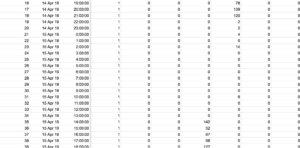The results:
Using the files provided, find the fly behavior monitor data from the three monitors used. Each file contains a chart with 42 tab-delimited columns.
Column 1. Index at reading (from 1)
Column 2. Date of reading
Column 3. Time of reading. Please start from line 13. 16:00:00. From this time on all monitors are read once every hour.
Column 4. Monitor status. 1= valid data received.
Column 5 to 10 are not used in this experiment.
Column 11. Channel 1
Column 12. Channel 2
…
Column 42. Channel 32.
Here is a sample of what the data table given looks like:

Conclusions:
From my understanding, the values provided in the data tables refer to how many times the fly crossed the center of the tube in the given time frame. Given this assumption, we can now make some observations about the data.
First, note that 18 out of 32 of the flies showed no activity at all. This is most likely due to them being over gassed with CO2 while preparing for the experiment and thus dying as a result. So, we will move to analyzing the data provided by the flies that did survive.
Of the 14 flies left, 9 of the flies showed a regular sleep pattern at some point. Of those 9, 3 exhibited a distinct cycle, 2 showed a somewhat regular cycle, 3 began with having regular cycles and eventually followed an irregular sleep pattern, and 1 did not sleep but did follow a identifiable cycle between activity and limited activity.
Out of the 5 other flies, 2 had completely irregular sleep patterns, taking “naps” at random periods, 1 slept almost never, and 2 showed irregular sleeping patterns and eventually died.
Based on the limit data, we cannot make a definitive judgement on how the sleep pattern of the two types of flies were affected. However, we can see that certainly some of the flies showed signs of a circadian rhythm while others did not. Since it is not mentioned in the data table which of the flies expressed the gene and which did not, it is not possible to say whether the gene expression had anything to do with this pattern. However, if all of the regular and somewhat regular flies were of the same type expressed the gene while the others that slept irregularly were of the other type, then it is possible to see some connection between the gene expression and sleep.
If there is a connection, then the scientific community will be closer to understanding how genes can play a role in sleep and we will be closer to more fully understanding the big mystery of how and why we sleep.
Connection to Robotics:
While this experiment may not seem to have a direct connection with robotics, rather than the experiment, it is the way in which it was conducted that has a connection with the field of robotics. Like with any experiment, it is common practice to have two groups between which there is only one variant, in this case the expression of a gene. Based on your experiment, you can then deduce if the variant is the cause of and issue or not. Similarly, in robotics, when something goes wrong, or there is a bug in the code, or a problem with the hardware, rather than change many things at once, it is common practice to isolate parts of code, or physical parts of the robot and test those parts individually to see if they are the ones causing the issue. In this manner, we can see how the scientific method and hypothesis testing is something that is universal amongst all fields of science.